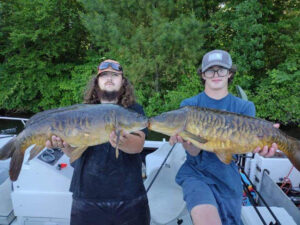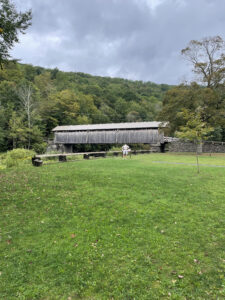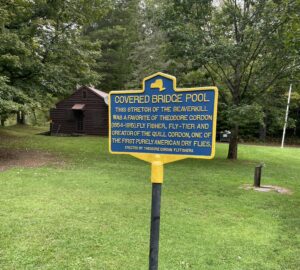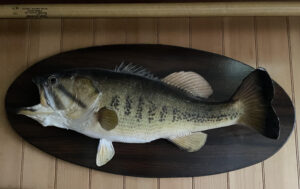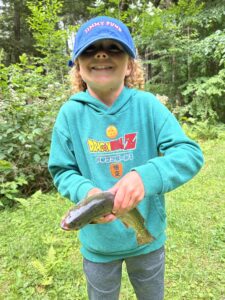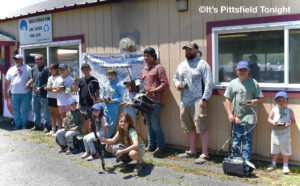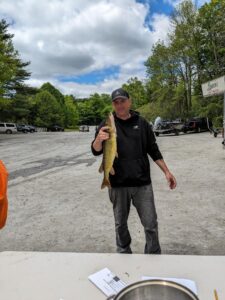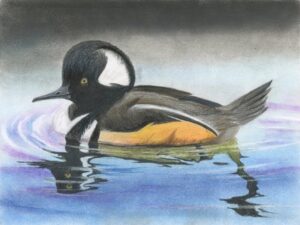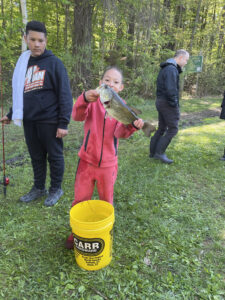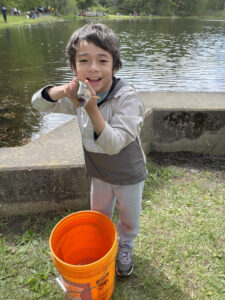On Saturday, June 15, the Carp Palooza fishing derby was held on Pontoosuc Lake. According to organizer Josh Christman, this was a record year with 37 teams. Robert Houghtlin and Payton Quinn were this year’s champions. They had a total weight of 29 lbs, with the lunker being over 15 lbs. They received the winning belts and over $1,000 for having won the tournament and the Lunker Pool which is the heaviest carp.
With an earlier start time, they saw teams with their kids making a day of it. Christman plans the same start time again next year because people enjoyed the earlier time start. Next year he also hopes to add a kid’s division so they can also participate. This year he awarded a child a gift card because the father sent Christman the video of the child catching a carp. “It was great seeing people participate as a family.” said Christman. He said that from now on, the derby will be moving to Onota Lake permanently.
Raffles were offered this year and they were able to raise over a $1,000 which was handed to Steve Bateman to be added to the donations for the Jimmy Fund.
Christman thanked the sponsors: Berkshire Tree Service, Lakeside Bar & Grill, Onota Boat Livery Jsmegal Roofing & Gutters, Dave’s Sporting Goods and Dicks Sporting Goods. He also gave a huge thank you to Steve Bateman, Brandon Murray, Andrew Christman and Conor Graham for helping out with Carp Palooza this year.
An Act Modernizing Firearm Laws
Recently, the MA House of Representatives and Senate voted on H.4885 (An Act Modernizing Firearm Laws). The House vote was 124 yeas, 33 nays and 2 not voting. State Representatives Barrett and Farley-Bouvier voted yea and Pignatelli did not vote. The Senate vote was 35 yeas and 5 nays. State Senator Mark voted yea.
Incidentally, after many years Smitty Pignatelli is not seeking re-election and there are currently 4 candidates running for his seat. Before casting your vote this November, perhaps you should find out how each one would have voted on H.4885.
It is quite lengthy (116 pages) and, at the time of this writing, is still being reviewed by GOAL (Massachusetts Gun Owners Action League) and others. It would be impossible for me to delve into it as it is so lengthy it would take several columns to list and explain its contents. Also, I am receiving conflicting information as to what exactly is in that bill and am afraid to comment on it at this time for fear my information may be inaccurate and would only add to the confusion.
I’m not hearing good things about some aspects of it. For starters, according to Mass Conservation Alliance (MCA) Co Chair Wayne M. Adams, one now must have an LTC (license to carry) in order purchase, possess, transfer, etc. all semi-automatics firearms. ( A LTC costs $100.00 and must be renewed every 6 years.) FID card holders are banned from privately transferring or purchasing 1) large capacity firearms and feeding devices and 2) all semi-automatic firearms.
In the upcoming weeks, this column will provide more information on the many aspects of this bill. I doubt this new law will change anything and only the law abiding gun owners will abide by these laws and that it will have little or no effect on people with evil intentions.
The Landship Partnership Program
The Healey-Driscoll Administration recently announced over $3 million in grants to conserve large acreages of essential land across Massachusetts. Through the Landscape Partnership Program, the Executive Office of Energy and Environmental Affairs (EEA) awarded three grants to expand public recreational opportunities, improve water supply protection, support agriculture, and promote healthy ecosystems. The grants from the program will also support the Forests as Climate Solutions Initiative to protect high-quality forested land.
“Investments in land conservation are critical to strengthening climate resilience in our communities. Thoughtfully conserving our natural landscapes is also essential for reducing emissions and safeguarding the diversity of our ecosystems,” said EEA Secretary Rebecca Tepper. “Successful partnerships between agencies and organizations such as these can have a profound impact on enabling residents to enjoy the outdoors.”
The Landscape Partnership Grant Program was established in 2011 to facilitate large-scale projects that foster healthy ecosystems, protect the viability of farm and forest economies, and expand public outdoor recreational opportunities via state, municipal, and non-profit partnerships. This year’s awards will conserve over 1,300 acres in Berkshire and Plymouth County. The implementation of these grants will support the administration’s efforts toward building climate resilience and safeguarding critical natural landscapes.
“I want to thank Secretary Tepper and the Healey-Driscoll Administration for making this important investment into crucial land conservation efforts in Southeastern Massachusetts,” said Senator Marc R. Pacheco (D-Third Bristol and Plymouth). In addition to ensuring healthy ecosystems, protecting water supply, and creating recreational opportunities, these grants protect areas that, through carbon sequestration, play a part in the Commonwealth’s efforts to meet their requirement of being Net-Zero by 2050.”
One of the Landscape Partnership Grant Program awardees is The Trustees of Reservations, Sheffield Land Trust, and MA Department of Agricultural Resources (MDAR) – Cooper Hill Farm Project. A $1.25 million grant to protect 538 acres that are part of a broader, regional effort to conserve 1,130 acres of critical ecological habitat, forestland, and active agricultural landscapes in Sheffield, MA and Salisbury, CT. The Project will purchase an Agricultural Preservation Restriction (APR) from Pine Island Farm, one of the largest dairy farms in Massachusetts, ensuring the farm remains in agricultural use in perpetuity. The project will also extend protection to 40 acres of MassWildlife’s Natural Heritage and Endangered Species Program (NHESP) designated Priority Habitat for Rare Species and expand public enjoyment of Bartholomew’s Cobble which is managed for passive recreation and habitat values by The Trustees of Reservations.
The other two grant awardees are: Buzzards Bay Coalition, Town of Carver and Town of Wareham – Weweantic River Headlands Conservation Project: $1.25 million to protect 280 acres of forested uplands, cranberry bogs, and riparian wetlands along the mainstem of the Weweantic River in Carver and Wareham.
Buzzards Bay Coalition and MA Department of Fish & Game (DFG) Division of Fisheries & Wildlife (MassWildlife) – Sippican Headwaters Landscape Project: $1.25 million to protect 499 acres of forested uplands and wetlands at the headwaters of the Sippican River in Rochester and Middleborough.
12-Pound, 6-Ounce Largemouth Bass Breaks 37-Year NY State Record
Recently, New York State Department of Environmental Conservation (DEC) Interim Commissioner Sean Mahar announced that a new state record for largemouth bass was set on July 11, 2024. James Britenbaugh of Pennsylvania reeled in the record-breaking 12-pound, 6-ounce largemouth bass from Cayuga Lake, Cayuga County while fishing in preparation for an upcoming bass tournament. The record-breaking catch surpasses the previous 37-year-old State record largemouth bass, caught from Buckhorn Lake, Otsego County, in 1987 by one pound and two ounces.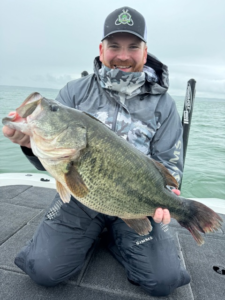 James Bitenbaugh.
James Bitenbaugh.
“It’s no secret that New York has the best bass fishing opportunities in the country and Mr. Britenbaugh’s incredible fish certainly confirms that,” Interim Commissioner Mahar said. “DEC encourages all anglers fishing in New York to check out the Angler Achievement Awards Program before dropping a line in the water. It’s an exciting program that recognizes sizable catches and shines a light on the numerous lakes, rivers, ponds, and streams producing trophy-sized fish right here in New York.”
This year, New York State landed five lakes on Bassmaster Magazine’s Top 100 Best Bass Lakes in the country. Among the New York waters included are the St. Lawrence River (Thousand Islands), ranked as the best bass water in the nation, and Lake Erie/Upper Niagara River, ranked as the seventh-best water. Lake Champlain, Cayuga Lake, and Oneida Lake made the list as well and are in Bassmaster Magazine’s Top 25 Northeastern Best Bass Lakes of 2024. Other waters across the state also offer exceptional bass opportunities and New York continues to be a destination for world class fishing.
Incidentally, the state record for largemouth bass in Massachusetts is 15 lbs, 8 oz and it measured 28 inches. It was caught out of Sampson Pond in Carver by Walter Bolonis in1975.
Catskill fishing trip – Part 2
Last week’s narrative of our flyfishing trip to the Catskills ended at the Covered Bridge Pool on the Beaverkill River where Paul Knauth and I stopped on Day 3 of our trip for lunch at a picnic area. You may recall that there we told an old timer where we thought the Rhododendron Pool was located. He had been searching for that pool for years.
From there, we went back to fish Ferdon’s Pool on the Beaverkill River where we had pretty good luck the night before.
This time Paul fished the tail end of the 200 yard pool and I returned to the rapids entering it. I brought two fly rods to the waters, my trusty L.L.Bean graphite and an old bamboo rod named the Scotty, which was made by Sharpe Co. of England. I have no idea how old that rod is. The plan was to catch one trout with that rod, put it down and continue fishing with the L.L. Beaner. I didn’t want to risk breaking that old classic bamboo rod like I did last year with an old Orvis bamboo rod. Well, I ended up fishing all evening with that rod because I never caught a fish. Paul managed to catch only 1 trout. The fish just weren’t biting.
After returning to the motel, we joined the other anglers around a campfire. Two young German fellows who were in the US on a business trip and who were staying at the motel joined us and brought along some beer. (What else?) Paul and I opted for a splash of bourbon in his fancy glasses which he always brings on our trips. The German fellas had never fly fished before and on that day hired a fishing guide to take them out. One of them caught a trout and he was elated and is probably now hooked on fly fishing.
Feeling better from his bout with vertigo, Dwight Atkinson showed up and he brought a peach pie which we all shared. It was a wonderful evening of comradery. Later, when we returned to our room, Paul suggested that I look at the bottom of his empty glass. Standing there with wings upright and happy as a lark was a live blue winged olive mayfly. We had a good laugh over that.
On Day 4, (Wednesday), we had breakfast at a local diner and just as we were leaving, Paul struck up a conversation with an old gent who knew the area quite well and he gave us some advice as to where to fish on the Willowemoc River.
We checked out one area which wasn’t to our liking as it was not a large area and would probably be crowded if another angler showed up. We checked out the second area mentioned, Dettes Pool and Roscoe Riverside Park, and we found a good looking pool to fish. We decided to fish it that evening after having another lunch of overstuffed sandwiches with a hint of yellow pepper juice followed by my wife Jan’s delicious chocolate chip squares.
It was at the park that we saw the famous 2-Headed Trout sign. (See footnotes below about the Dettes and the 2-Headed Trout.)
When we arrived at the pool, we were disappointed to see that two anglers were there already. So, we found another decent looking spot further downstream and began fishing there. Paul fished downstream toward Junction Pool while I fished the bumpy pocket water upstream with my trusty AuSable Wulff dry fly. The fishing was incredible! It seemed like every piece of pocket water contained a trout. When I worked up near the pool where the two fishermen previously had been, I saw that they had left. Moving right in, I proceeded to have the best fishing in many years.
Around 8:00 p.m., I started fishing back downstream toward Paul and the fishing was even better than when I fished upstream – the fish were larger. I won’t mention how many trout I caught, for readers probably wouldn’t believe me. It was one fish after another, almost every cast for 3 hours. Nice sized trout too, with the largest being 15 inches – all on the same fly, the AuSable Wulff dry fly.
The fishing was so good that I practically had to hide behind bushes and trees in order to apply floatant and refresh the fly, lest a trout would jump and try to take it right out of my hand and perhaps bite me in the process.
Just before dark, while fighting a 15-inch brown trout, I saw another even larger trout jump nearby. After landing the 15 incher, the fly was all beat up, bent and starting to unravel. But I tossed it out near the big fish anyway. Bam! Did it hammer it! When it realized it had been hooked, it immediately shot straight across the river to where there were some submerged slate rocks, swam around one and cut my leader. I had the distinct feeling that fish had used that tactic before.
By then it was too dark to tie on another fly so I watched Paul fish for a little while before total darkness set in. No problem for I had never caught and released that many trout in a day, much less three hours. Retired Dr. Charles Wohl of Lenox has an apt description for fishing times such as these….. “obscene.”
Paul also had a good night of fishing with his old Orvis bamboo rod and using Copper Johns and Gold Ribbed Hares Ear nymphs
That was a lucky evening for me in another way, too. One time I slipped and went down falling on my L.L. Bean flyrod. Fortunately, it didn’t break. But if I had been using that old bamboo Sharpe rod that I used the night before, it would surely have been shattered and it would have tainted an otherwise perfect evening.
When we returned to the motel, it wasn’t long before word got out about my unusual success. I was treated like a celebrity that night with people stopping by to offer congratulations and asking what fly I had used. For a while, I considered charging a consultant fee.
Mike Mcgowan, an angler from Idaho, was very interested in the fly and was going to purchase one the following day, as was Dwight, who was feeling even better and was able to start fishing.
Paul and I headed home that Thursday morning and while on the road, Mike texted telling us he purchased an AuSable Wulff dry fly and proceeded to catch a 20-inch brown trout that morning. Dwight stayed on and fished until Saturday. He fished the Dette Pool and one day he netted 7 trout with the same fly.
No, we never met up with Iron Mike, the big brown trout, on this trip. Instead of returning time after time to the same spot where we last saw him, we opted to fish new places such as the Rhododendron Pool, Covered Bridge Pool and the Roscoe Riverside Park and I’m glad we did. How could I be disappointed after having one of the finest days of fly fishing in my entire life amid such beautiful surroundings? Paul and I look forward to another flyfishing trip to the Catskills this fall, a little more knowledgeable about its wonderful rivers than we were before.
*Walt and Winnie Dette, along with their daughter Mary, tied flies from their home along the banks of the Willowemoc River for almost three-quarters of a century. They had been part of the tradition of Roscoe, a center of fly-fishing, and were the last of the renowned school of the Catskill FlyTiers. Walt was one of the major links in a chain that reaches back to Theodore Gordon, long considered by many as the father of dry-fly fishing in this country. Established in 1928, it is claimed that Dette Flies is the oldest family run fly fishing shop in the world.
** The 2-headed trout sign reads as following: “Legend holds that a trout swam to Juncture Pool where the Beaverkill and Willowemoc meet. Unsure of which way to go, it started left and right. Remaining in one spot so long, the trout grew a second head. To this day, people say they have seen it, but no one has caught it.”
Exciting times fly fishing in the Catskills
As noted in last week’s column, this and next week’s columns will be devoted to Paul Knauth’s and my June flyfishing trip to the Catskills in NY. I was hoping to have another chance at catching a large brown trout in the Beaverkill River that I missed several times last year.
We arrived at the Roscoe Motel in Roscoe, NY around 3:00 pm on Sunday, June 2 and there to greet us was Dwight Atkinson of Virginia who we first met last fall and have since developed a close friendship. He’s the guy described in my February 24, 2024 column entitled “You meet the most interesting people while fly fishing in the Catskills” as a person who fishes anywhere and anytime he wants. He made it a point to be in Roscoe for the rematch with that fabled big brown trout known as Iron Mike. On his way to the Catskills, Dwight stopped at a roadside pie store and purchased 4 homemade pies for the fishermen staying at the motel, which included people from MA, NY, NJ, VA, PA, Washington DC, MI, ID, Canada and Germany. Hey, the Catskills is the place for fly fishermen to be in early June.
Also there to greet us was motel owner, Rachael Yeager and her dog named Chuck. He is a very friendly old Yellow Lab who keeps an eye on the anglers and if someone should perchance leave their motel room door open, Chuck just goes in and helps himself to whatever food is on the table.
Incidentally, the motel is not more than 30 feet from the Beaverkill River. One can simply look out one’s motel room window and determine the river condition, flies that are hatching, whether fish are rising, etc.
After settling into our room, Paul and I headed for Iron Mike’s last known location on the Beaverkill River, the place where he cleaned my clock last fall. Luckily, no one was fishing that spot. Try as I might to entice Iron Mike to make an appearance and grab my fly, I wasn’t able to do so. The only fish in that stretch of water were 5-6 inch trout. If Iron Mike was around, those fish would surely not be there for he would have munched them up like potato chips.
In the 3 hours we were there, Paul caught a couple of nice sized brown trout downstream from me, but there was no sign of Iron Mike. Perhaps someone caught him since we were last there, or maybe he simply died of old age. We did manage to catch 4 trout each that evening. When we got back to the motel the usual group of flyfishermen was not there outside their rooms, gabbing, drinking, etc. We thought for sure Dwight would be there with some pie but he wasn’t. So we turned in early.
The next morning around 7:00 a.m. we chatted with Nick Cobler from PA who was already sitting outside his motel room tying flies. He is one superb fly tyer and we marveled at his work.
After breakfast on Day 2 (Monday) we visited a local fly shop to pick up some stuff and then headed out onto a Willowemoc River pool behind a rest stop on Rte. 17 near Roscoe. Not knowing the name of that pool, we simply called it the Rest Stop Pool. It was getting hot, so instead of wearing chest waders, Paul opted to go wet wading. (No chest waders, just shorts, wading shoes and wading socks). He fished upstream from me.
When we concluded fishing and met up, Paul commented that on the other side of the river from where he was fishing, the whole bank was covered with Rhododendrons and that when they bloom, that place must be absolutely gorgeous.
While eating lunch, we discovered that the lid on a jar of yellow peppers was loose and the pepper juice leaked into Paul’s cooler affecting the taste and texture of our sandwichs and everything else in it. We could smell it every time we opened the cooler.
After lunch and resting, we headed for Ferdon’s Pool on the Beaverkill, a place we fished last year and had good luck. Paul fished upstream with tandem nymphs near the bottom while I fished the bumpy head waters leading into the large pool using my favorite fly, the AuSable Wulff dry fly. We both ended up catching and releasing 8 trout that evening. When we returned to the motel, once again Dwight was nowhere to be seen. We learned that some sort of vertigo or dizziness had overtaken him and it was so bad that he was bed-ridden Sunday afternoon and Monday. What a shame, for he planned the trip for months only to have that happen.
On Day 3 (Tuesday) we fished upstream of the Covered Bridge Pool on the Beaverkill River. That part of the river was too rapid, rocky and slippery for me. I couldn’t stand in it even while using my wading staff. Walking the path alongside it wasn’t much better. (I should mention here that in addition to having neuropathy in both feet, I also have balance issues going on these days.) Despite Paul’s offer to help me cross it, I opted to sit on a shaded rock and cast from there. Paul crossed and fished upstream.
It was terribly hot that day, and every now and then I had to dip my fishing hat into the water to cool my noggin. But I was content sitting in the shade and I even managed to catch and release a couple of trout.
While fishing there, an older gentleman passed behind me on the trail heading upriver. Good for him, I thought, for I couldn’t even walk on that difficult trail. When I looked upriver a few minutes later, I saw him attempting to cross an area of fast moving water about 70 yards away. Oh no! After making another cast, I turned to see how he was doing and there he was on his hands and knees in the middle of the river trying to get up. Each time he tried to stand he went down again. Ooh, this is not good! Fortunately, the river wasn’t so deep that he was in too much danger of drowning, but his waders must have filled with water and he was in a dangerous situation. The thought of him possibly having a broken hip or leg crossed my mind.
With no way for me to help him, I decided to call Paul, who was fishing further upstream out of sight, to see if he could come downstream to help him. Unfortunately, I accidentally left my cell phone in Paul’s vehicle. (I subsequently learned that there was no cell service there anyway).
I was beginning to panic, possibly more so than the old gent himself. After a fairly long time, he was able to get to his feet. Thankfully, it appeared that no body parts were broken. Now all he had to do was to work his way to the other side, not an easy task at all. Gradually, he made it. After he finally got to the other side and checked his flyrod for damage he looked toward me and we exchanged “Hooray!” signals.
When Paul returned and helped me get out of the river, up the bank and back to the park area, we sat at a picnic bench and ate overstuffed sandwiches with a slight tinge of yellow pepper juice. Paul had some good fishing upstream catching a 15 inch rainbow trout and a 16 inch brown trout along with several other nice fish.
Just before leaving, we met another older gent who had just stopped fishing. He told us how he used to fish the area with his father and grandfather. In fact, his great grandfather used to camp on some farmer’s land around there way back when. Over the years, he made it his mission to fish every one of the areas about which his grandad spoke. He was able to fish them all, except one place which he could never find, a place that his grandad called Rhododendron Pool. When Paul told him about that pool behind the service area where he saw all the rhododendrons, the old gent was elated and said he said he couldn’t wait to fish that place.
To be continued next week.
Now’s a good time for bass fishing
Summer time is a great time to bass fish. The most successful bass fishermen seem to prefer rubber worms or sluggos and such.. Others prefer crankbaits, buzzbaits, spinnerbaits, jigs, live bait, etc. I’m still fishing with some plugs purchased over 65 years ago, and they still work. Old fashioned topwater plug such as Arbogast Jitterbugs or Hula Poppers, Heddon Crazy Crawlers or floating River Runts, etc. When they don’t work, underwater plugs like the Worden’s Flatfish, Rapala Minnows work. Now and then I even use a home made wooden plug made and given to me years ago by Dave Mackey of Pittsfield.
This is the best time of year to use top water bass plugs. There’s nothing more exciting than fishing at dusk and having a big bass come up to the top and shatter the silence with an explosive hit on a floating plug and then jumping several times trying to shake it off..
Bass fishing out of a boat is fun, but not absolutely necessary. There are still open shorelines where you can “plug” along.
Some of my fondest memories are of plugging away on Laurel Lake or Stockbridge Bowl all night long with my best friend and school classmate Jerry Zink. We were teenagers back then, too young to have driver’s licenses. Jerry’s dad or older brother would drop us off in the early evening and pick us up the next morning. At Laurel Lake, we rented an old wooden rowboat for the night from Bing Miller’s boat rental for $2 or $3 dollars. Yeah, they leaked a little, but that never bothered us.
How well I remember Jerry and I fishing one night when a pretty severe thunder storm hit us as we were out in a rowboat on Stockbridge Bowl. While seeking refuge from the lightning and rain, we rowed to the open boathouse that Shadowbrook Jesuit School owned. We brought some butter and flour in a jar and planned to cook up some fish for a snack sometime around 1:00 or 2:00 a.m. The fishing was lousy that night and all we had caught were a couple of dinky bluegills. After cleaning, scaling and flouring them we threw them on our stove…………….a tiny sterno burner. We couldn’t get enough heat to cook the fish which were somewhere in the gooey paste. Ugh! I almost gave up eating fried fish after that episode. Once or twice a year, Jerry and I still chuckle over that.
How well I remember one night shortly after I got out of the service fishing alone out in one of Shadowbrook’s rowboats on Stockbridge bowl. It was a peaceful late summer evening filled with sounds of bullfrogs and mallard ducks. I was 100% focussed on the sound of my popping bass plug in the darkness. When all of a sudden there was a horrific flash which lit up the sky and a loud explosion, followed by several more. After I crawled out from under the rowboat seat, I realized that the commotion was fireworks coming from Tanglewood. Apparently, they aimed the fireworks in the sky over the lake so as not to accidentally start a fire. The guys at the office got a charge out of that when I related the event. “You should have read the newspaper”, they said, “they mentioned the upcoming event.”
As the song goes, “Precious memories, how they linger.”
Kids fishing derby and more at the Berkshire National Fish Hatchery
Next Saturday, July 13, the Friends of the Berkshire National Fish Hatchery Board invites you to join them for a free pancake breakfast to kick off derby day at 7:30 a.m., at the hatchery, 240 Hatchery Road, New Marlborough. A chance to fill up on delicious pancakes before heading down to the Derby Pond for some exciting fishing action.
At 9:00 a.m., the derby (for kids ages 13 and under), kicks off with more tagged fish added to the pond, guaranteeing good fishing. Don’t miss out on the chance to win great prizes and snag one of their exclusive derby t-shirts. The derby ends at 10:30 a.m.
This should be a good morning of fishing fun and delicious food.
MEP Entrance Exam
Lieutenant Tara Carlow from the Massachusetts Environmental Police informs us of an upcoming MEP entrance exam for qualified, interested candidates. This test is offered only every 3-5 years. The application deadline is July 16. For details, click onto
https://www.mass.gov/info-details/2024-environmental-police-officer-ab-examination
Good things happening on the Hoosic River
On Thursday, July 11, beginning at 6:30 p.m., the Taconic Chapter of Trout Unlimited (TU) is sponsoring a Hoosic River Cleanup to pick up trash, tires, etc. in the North Adams stretch of the Hoosic River. Volunteers meet at the Ashton Ave boat launch.
Some gloves and bags will be available, but bring your own gloves, cleanup tools, boots and tick prevention. Waders and hip boots are encouraged but not required. No need to RSVP.
In case of excessive rain and/or unsafe conditions, a notice will go out to the Taconic TU email subscribers, and be posted on its social media (Facebook and Instagram) around 10:00 a.m. on July 11.
Additionally, according to its most recent issue of the Backcast, (Taconic TU’s quarterly newsletter) they have a bacteria monitoring program underway on the Hoosic River with the Hoosic River Watershed Association (HooRWA). This is a great collaborative project which will add to the data on the health of the river.
They also have a new 3-year temperature monitoring project on the three branches of the Hoosic River (North, South and Main) under way. One of the greatest threats to the health of fish on the Hoosic is the rising water temperature. To their knowledge, this 3-year citizen science study will be the most comprehensive temperature monitoring of the 3 branches of the Hoosic to date.
Justin Adkins, president of the chapter, has these words of advice : “As you fish this summer, please remember that when the water temperature is 68F or more, don’t fish for trout. We have some great bass and carp waters here in Berkshire County. When the water is warm it is time to leave the trout alone and go explore some new waters.”
New Ducks Unlimited Chapter Formed
On July 27, the State Line Chapter of Ducks Unlimited will have a Kickoff Banquet at the Stockbridge Sportsmen’s Club, 24 West Stockbridge Road , Stockbridge.
Doors open at 5:00 and dinner starts at 6:00 p.m. There will be a buffet style pasta dinner, a silent auction, general raffle and special gun raffles. Individual tickets cost $60, couples $100, and sponsor tickets will also be available.
Tickets may be obtained at: HTTPS://SHORTUR.AT/DLUVD or by contacting Joe DelSoldato, Ducks Unlimited Area Chairman at 413-717-0938.
What to do with those old fish mounts
Jim Legacy, MassWildlife ‘s Aquatic Resource Education Coordinator, asks if you have an old fish mount that’s collecting dust? Maybe you inherited one which meant so much to your grandpa, father or uncle, or have your own mount of a nice fish that you caught years ago. Perhaps its time to downsize and you just won’t have the wall space anymore to display it.
Legacy suggests you consider donating it to MassWildlife’s Angler Education Program.
They use fish mounts to show what a fish looks like and how anglers can catch one just like it during its Learn To Fish clinics. Their current mounts are ready for retirement and they’re looking for replacements that are in good condition and looking for a new home.
If interested, contact Jim Lagacy at jim.lagacy@mass.gov to coordinate a donation.
Headed for the Catskills
Readers may recall that last year Paul Knauth of Hinsdale and I took two fly fishing trips to the Catskills (NY) to fish the Beaverkill and the Willowemoc Rivers. You may remember that 2 or 3 times I hooked into what we believe was the same big brown trout in the spring and the fall. Every time that fish pushed me around, spitting the AuSable Fly back at me, breaking my fly line leader, stripping my reel down to its backing and probably giving me the fin.
That fish became a legend, known as Iron Mike, named after the heavyweight boxing champion Mike Tyson who practiced for his title fights in the Catskills. Well, this past June, we went back to fish there again and to try to find and to do battle with Iron Mike again. The narrative starts next week.
Antlerless deer permits remain unchanged this year
While giving his annual deer report to the June 18 MA Fish & Game Board Meeting, DFW Deer & Moose Project Leader Martin Feehan recommended no changes in the number of antlerless permits to be issued in 2024. The number are the same as they were was in 2022 and 2023. Also, there have been no changes in the permit numbers in the individual wildlife management zones. The allocated permits are as follows:
Zone 1 – 800 allocations, Zone 2 – 400, Zone 3 – 2,050, Zone 4N – 800, Zone 4S – 600, Zone 5 – 1,950, Zone 6 – 400, Zone 7 – 3,000, Zone 8 – 3,100, Zone 9 – 7,200, Zones 10 and 11 – no cap, Zone 12 – 1,350, Zones 13 and 14 no cap.
Note, Zones 1 through 4 are the zones in our area:
Once again zones 10, 11, 13 and 14, in the eastern part of the state, have no caps on antlerless permits as they are still having troubles getting the deer population down to targeted deer densities.
Antlerless deer tags are allocated by zone based on population goals in that zone. Most hunters apply for their permit when they purchase their Massachusetts hunting license, but you can also apply online by going to MassFishHunt or in person by going to one of the MassWildlife District Offices or the MassWildlife Field Headquarters in Westborough.
The deadline for applying for an antlerless permit is July 16. If you apply, you still must check to see if you have been awarded the right to purchase the permit.
The award period begins August 1 at 8:00 am and ends on December 31. Your odds of obtaining a permit are the same regardless of when you check your permit status. You can check the status through MassFishHunt or by visiting a MassWildlife office or license agent location. There is no fee for the application, but those who are successful are required to pay a $10 fee.
Feehan also recapped some new proposed dealing with controlling the spread of Chronic Wasting Disease (a transmissible spongiform encephalopathy affecting deer. It is in a family of diseases thought to be caused by misfolded proteins called prions and include similar diseases such as mad cow disease in cattle, Creutzfeldt–Jakob disease in humans and scrapie in sheep.) One proposal is to set a sunset (phasing out) of Massachusetts facilities that raise captive deer. Another deals with expanding the deer deboning requirements.
Feehan further recapped proposed regulations that: 1) clarify that food plots are legal to hunt, 2) authorize deer decoys during archery season, 3) remove the daily antlerless bag limit, 4) authorize the youth deer permit for all season long, 5) exempt shed hunting from possession permit requirements and 6) create a winter primitive deer hunting season for the month of January in Wildlife Management Zones 13 and 14 (Martha’s Vineyard, Elizabeth Islands and Nantucket).
After considerable discussions, the Board approved moving the proposals forward to public meeting.
The specific verbiage for these proposals was not made available during the Board Meeting, and I am not able to expand further on them. I’m sure we will be hearing a lot more about them in the near future.
“It’s not the fishermen, but the fly”
Recently, I received the following email.
“A few weeks back, on a beautiful June evening, I was standing knee deep in a local river. Earlier, I had landed a couple decent browns; however, there were long dry spells in between. The fish were rising but no takers. This fellow fishing below me seemed to be hooking up on every other cast. In the fading light, with fish rising all around me, the fellow waded up to me and offered me his rod, taking mine in turn. I accepted the offer. Miraculously, I proceeded to land a nice brown followed very quickly by another and another and another. When it became too dark to see, the count had reached 5. I turned to the fellow, handed back his rod and thanked him. It was then I added, “It’s not the fishermen, but the fly.”
Kind of a weird email, right? What’s that all about? Gosh, that event seemed so familiar…like I experienced the same thing, …almost like an out-of-body experience. Then it dawned on me. The person in that story is me! The fellow who offered me the use of his rod and fly is a good friend and he actually wrote the article. He asked that if I included the story in this column, not use his name. “It will be our secret” he wrote, “as it is one of my most cherished memories fishing with a very special person.”
Aw, shucks.
Actually, it probably was the fisherman. A good fisherman not only knows the right fly to select, the size, color, the type of waters, the time to use it, etc. The other fisherman knew all that, I didn’t.
Thank you for that experience, my friend, and I won’t forget it either.
Report fish kills
Even though the vast majority of summer fish kills are natural events, to ensure there is not a pollution problem, MassWildlife advises us to a report all fish kills in lakes and ponds by calling the Environmental Police Radio Room at 1 (800) 632-8075
Natural fish kills are most often caused by low oxygen levels, fish diseases, or spawning stress. Depletion of dissolved oxygen is also a common cause. Water holds less dissolved oxygen at higher temperatures, and in shallower or weedier ponds, levels can drop further as plants consume oxygen at night. Fish spawning, including sunfish and bass spawning, occurs in late spring and early summer in shallow waters near shorelines. These densely-crowded areas can grow more susceptible to disease outbreaks as water temperatures rise. The result is an unavoidable natural fish kill, often consisting of only one or two species of fish.
Pittsfield Sportsmen’s Fishing Club derby
On June 8, the Pittsfield Sportsmen’s Club held a fishing derby at Reynolds Pond in Cheshire. According to club spokesperson Sandra Bushey, no one caught any of the 3 tagged trout. Nevertheless, the 8 kids who participated still had a great time.
Steve Bateman was there. ”Since putting on the (Jimmy Fund) derby, I really don’t get any fishing in prior to it.” said Steve, “ I only went out twice, once it was 36°. I recently got to take my nephew Christopher ‘Bub’ Bateman.” (Bub or Bubby is his family name) “He’s a nine year old student at Egremont School in Pittsfield. He has never caught a fish by himself until today at the Children’s Fishing Derby sponsored by the Pittsfield Sportsmen’s Club. I couldn’t be more proud of him. The way he cast, set the hook and brought the fish in. We still need to work on taking them off the hook, but I’m sure we’ll have that mastered in no time.”
“He caught his first fish, a rainbow trout then he caught other very nice brook trout. We kept three of them for his mom. It was a great experience for him. A big thank you to Dave Pemble and the rest of the crew of the Pittsfield Sportsmen’ Club for putting this event on.”
Ah, its good to see Steve just being an uncle and taking his nephew to a fishing derby without having the headaches and responsibility of overseeing a big event such as the Bateman Jimmy Fund Derby.
Good dogs, good food
On June 8, a SPO (Small Pack Option) Derby was held at the Berkshire Beagle Club on hares and cottontail rabbits. It was a one-day trial for dogs under 2 years old. Two classes were run, 13-inch and 15-inch., both classes combined males and females. Some thirty-two dogs in all were registered, nineteen 15” and thirteen 13”.
The winners were as follows: Zachary Johnson from Salem, NY took top honors in the 13” combined class, and Tony Roderick from Deighton, MA took top honors in the 15” combined class.
Berkshire Beagle Club member Bryon Faulkner took 2nd and 3rd places with his dogs 5 Pine Swamp’s Little Blue Ruby and Swamp’s Lunar Eclipse.
Coffee, juice and donuts were served in the morning. Wild turkey club sandwiches and rabbit pot pie gravy over biscuits for lunch. Umm, umm.
Bateman Memorial Fund Fishing Derby breaks another record
According to event organizer Steve Bateman, the 32nd annual Harry A. Bateman Memorial Fund Fishing Derby was a huge success this year mainly in part because of all the great sponsors that supported the event and the great team that put this event on. The derby, which was held on June 1, had another record-breaking year with attendance and funds raised. Some 330 registered anglers plus another 30-40 people. They raised a record-breaking $13,500+ for the Jimmy Fund.
The largest fish weighed in was a 16 lbs. 4 oz Common Carp caught by Joe Trybus. This was also the largest fish ever weighed in the history of the fishing derby.
New to the derby’s sponsors this year was Joe Garzone of Berkshire Taxidermy who was kind enough to mount the winning trout in the children’s category. Certainly a gift to remember for a lifetime. They also had Chuck Maces of Maces Marine who donated the use of a pontoon boat for the entire day. Carlo Torra and John Erbin from COBB of Western MA brought children and parents throughout the day to experience fishing from a boat. For some it was their first time.
Free worms were provided by Onota Boat Livery. Mayor Peter Marchetti, Councilor Pete White and former Councilor Karen Kalinowski were in attendance. “There was so much support from our community that people from all over the county and other states attended this event,”said Bateman, “two people in attendance, Joe Monterosso and Sue Crawford, traveled in their electric wheelchairs, a 6 mile round trip for the 2nd year, to come to the fishing derby.”
Bateman feels that transportation for the handicapped community will be something that needs attention for next year’s Fishing Derby.
A great time was had by all.
This year they had several repeat winners at this event. The winners as reported by Steve are as follows:
CHILDREN HEAVIEST GAME FISH CATEGORY
1ST. PLACE: MASON KUCKA – NORTHERN PIKE 3 LBS. 13 OZ.
2ND. PLACE: QUINTYN SHUTTLEWORTH – LARGEMOUTH BASS- 2 LBS. 6 OZ.
3RD. PLACE: MILA OSTELLINO – RAINBOW TROUT – 1 LBS. 11 0Z.
CHILDREN HEAVIEST NON-GAME FISH CATEGORY
1ST. PLACE: CLOE SHUTTLEWORTH – BOW FIN – 6 LBS
2ND. PLACE: RAYCHELLE ERRICHETTO – BULLHEAD – 13 OZ.
3 RD. PLACE: CASSIDY WOJNICKI – BULLHEAD – 11 OZ.
ADULT HEAVIEST GAME FISH CATEGORY
1ST. PLACE: JORDAN PASQUARELLI- LARGEMOUTH BASS- 2 LBS. 10 OZ.
2ND. PLACE: DA’JAUN MERENDA– CHAIN PICKEREL – 1 LBS. 13 OZ.
3RD. PLACE: MIKE STORIE – LARGEMOUTH BASS- 1 LBS. 12 OZ.
SPECIAL HEAVIEST FISH 1ST. PLACE AWARDS
BASS: JIM BAK-LARGEMOUTH BASS – 3 LBS. 3 OZ. ADULT
PERCH/CRAPPIE: NICK SAYERS – CALICO BASS – 11 OZ.
CARP: JOE TRYBUS- COMMON CARP- 16 LBS. 4 OZ.
TROUT ADULT: JAKE BURKE – RAINBOW TROUT 2 LBS. 5 OZ.
CHILDREN TROUT: ALICE CHRISTMAN – RAINBOW TROUT 1 LBS. 12 OZ.
SPORTSMANSHIP AWARD: DELCAN ABLE
BUTCH PATRICK TACKLE BOX: JULIANNA MATTHEWS
RAFFLE: 55” TV – DAVID HUBBARD
$100 LOTTERY TREE- KIM SORRENTINO
50/5O RAFFLE PAID OUT $385
ADULT DOOR PRIZE: GAS GRILL IN MEMORY OF CARL DELUCE: ALBERT ADAMS
Cindy Delpapa honored
The Wild & Scenic Westfield River Committee recently awarded Cindy Delpapa, of Becket the Bob Thompson award for her dedication to the river and the breadth of knowledge she shared for the benefit of all. The news release mentioned “her high standards and clarity of focus guided the committee through an update of the strategic plan, development of a website focused on action, and a model for funding culvert replacement across the watershed that improves safety and river habitat at the same time.”
“Cindy was instrumental in launching two new initiatives, “Rooting out Barberry” and exploring “Brine for Pretreatment” to prevent ice from forming on our Hilltown roads in winter. Cindy brought Action Research in to assist the committee with developing campaigns that speak directly to the audience the committee is trying to reach in a manner that is clear, inspiring and motivating.
If you are interested in the committee’s work or participating in its initiatives visit https://westfieldriverwildscenic.org/.
Meredyth Babcock, volunteer and projects coordinator for the Wild & Scenic Westfield River Committee, gives us more information about Cindy. “After more than 25 years of service to the people of Massachusetts, the Department of Environmental Restoration’s (DER) Cindy Delpapa retired in late 2021. Cindy brought wide and deep expertise in water quality, stream ecology, estuarine ecology, regulatory policy, and grass-roots action to the Riverways Program and DER. She focused on urban river revitalization, streamflow restoration, and water quality restoration; however, she was truly interdisciplinary, always asking herself what the rivers need and adapting her work accordingly. In addition to her subject matter expertise, Cindy brought exceptional compassion to her work.”
“Always modest, Cindy would be surprised to know that she was perceived as a role model and mentor by many at DER. Countless rivers and wetlands benefited from her restoration expertise. We miss her wisdom and knowledge daily and wish her the best in her new adventures.”
Advice on consuming our local fish
The Massachusetts Department of Public Health samples the water and fish throughout Massachusetts for high levels of mercury and forever chemicals known as PFAS. The Mass. DPH then issues advisories for what fish should not be eaten based on where they are caught.
Mercury is a naturally occurring metal that is found in the environment but can also be released by coal-burning power plants. Fish with mercury can still be consumed in some cases but should be limited to less meals per month.
PFAS, Per- and poly-fluoroalkyl substances, are chemicals that have been used since the 1950s for stain-resistant, water-resistant and non-stick products. PFAS are commonly used in food packaging, clothing and other products. One source of contamination has also come from firefighting foam. Consuming these forever chemicals over an unknown amount of time has been associated with increased levels of cholesterol and live enzymes as well as an increase in the risk of high blood pressure and pre-eclampsia in pregnant women.
There is no way to remove these chemicals from fish already contaminated. They can not be cut, cleaned or cooked out, according to DPH.
The following bodies of water in Berkshire County have been issued advisories as of May 2024. If you are more sensitive to these types of hazards, it is recommended to avoid eating any of these fish:
Ashley Lake in Washington – Mercury Hazard – Limit Yellow Perch to 2 meals/month
Ashmere Lake in Hinsdale – Mercury Hazard – Limit Chain Pickerel, Largemouth Bass to 2 meals/month
Big Pond in Otis – Mercury Hazard – Do not eat Largemouth Bass, limit other fish to 2 meals/month
Buckley Dunton Lake in Becket – Mercury Hazard – Do not eat Largemouth Bass
Garfield Lake in Monterey – Mercury Hazard – Limit Largemouth Bass to 2 meals/month
Goodrich Pond in Pittsfield – PCBs Hazard – Do not eat any fish
Hoosic River in North Adams, Williamstown – PCBs, PFAS Hazard – Do not eat any fish
Housatonic River – PCBs Hazard – Do not eat any fish including frogs and turtles
Konkapot River in Sheffield, New Marlborough – Mercury Hazard – Limit all fish to 2 meals/months
Morewood Lake in Pittsfield – PCBs Hazard – Do not eat any fish
Otis Reservoir in Otis, Tolland – Mercury Hazard – Limit all fish to 2 meals/month
Plunkett Reservoir in Hinsdale – Mercury Hazard – Limit Largemouth Bass to 2 meals/month
Pontoosuc Lake in Pittsfield, Lanesborough – Mercury, PFAS – Limit Largemouth Bass to 2 meals/month, limit other fish to 2 meals/month
Silver Lake in Pittsfield – PCBs Hazard – Do not eat any fish
Upper Spectacle Pond in Otis, Sandisfield – PFAS Hazard – Limit all fish to 1 meal/week
Windsor Lake in Windsor – Mercury Hazard – Do not eat Largemouth Bass
The good news is that MassWildlife stocks local lakes and rivers with healthy trout twice a year which can be consumed.
Pittsfield Open Space & Recreation Survey
Pittsfield is updating its Open Space & Recreation Plan (OSRP) and needs your help. Your input will help guide the planning process and determine the future of recreation and open space in the city. The plan will make Pittsfield eligible for state reimbursement grant programs for the improvement of recreation areas and the protection of open spaces.
The survey, which will be open from June 6 to July 7, has questions that may be of interest to Pittsfield hunters and fishermen, so you might want to make your voice heard. The questionnaire is open to all residents, and responses will be confidential. Click onto https://www.surveymonkey.com/r/PittsfieldOSRP.
Joe Areno’s Legacy lives on
I think I first met Joe Areno, of Pittsfield, sometime in 1980 when I attended a Pittsfield Sportsmen’s Club (PSC) venison heart and liver dinner. At that time the club was having various fund raisers to help pay for properties that it acquired on Potter Mountain. The land was to be used for hunting and recreation. Joe was a director of the club who coordinated the event which drew large crowds and the tickets were hard to get.
Joe was well known in the outdoor sporting community as one who was instrumental in dealing with local, state, and federal agencies to help institute legislation that protected open space throughout the county and state and legislation to help protect sportsmen’s rights to hunt and fish. Because of those efforts, Joe was named the Berkshire County League of Sportsmen (BCLS) 2002 Sportsman of the Year. In acknowledging him, the League pointed out that (at that time) he had served on the Board of Directors of the PSC in every position for over 45 years. “Many times he traveled down to Boston at his own expense to meet with Senators and Representatives to express views on how to protect the habitat and wildlife of this great Commonwealth.”
Sometime around 2008 or 2009, Joe was diagnosed with terminal cancer and one day, when he was quite ill, his wife Doris called me and said that Joe was nearing death and that he wanted me to stop by and see him. He wanted one final chat and to give me something. Oh, how I dreaded it, but I thought the world of him and did visit him. We had a good chat and I remember him saying something to the effect that he had no complaints and that he had a pretty good life. (Even though he served in the Korean War and was a decorated veteran). After having a sad but pleasant conversation, we said our final good byes. That was tough.
When I was leaving, Doris told me that there was some fishing stuff that Joe wanted me to have. One of the items was a bamboo fly rod that Joe had purchased in 1955 in Japan when he was on R&R from Korea. I told Doris that I couldn’t take that rod but rather it should be kept in the family to be given to one of his kids or grandkids. Doris said that nobody, kids or grandkids, flyfished and that Joe really wanted me to have it and some boxes of flies. Doris said that it was one of Joe’s final requests that I have it. Reluctantly but graciously, I accepted it while silently resolving that before I pass beyond the riverbend, that rod must somehow be returned to the family.
After leaving their house, I headed for the East Branch of the Westfield River, below Chesterfield Gorge in Chesterfield to meet fishing buddy, Doug Yates and do some flyfishing. Upon arrival, I saw Doug fishing downstream and waved to him to let him know I had arrived. I didn’t immediately join him for I wanted to be alone for a while after experiencing what had just transpired. Honoring Joe, I opted to use his bamboo rod instead of my own. With teary eyes I rigged up Joe’s rod and entered the river.
How appropriate it was that shortly thereafter, I caught a nice rainbow trout using that rod. This is for you, Joe, I thought. Unfortunately, I never got to see Joe again and tell him about it, for he passed away shortly thereafter.
In Joe’s honor, I created a bucktail style fly which I named Areno’s Legacy. A half dozen of them were raffled off at the next sportsmen’s banquet and his close friend the late Cleante ‘Clem’ Caryofilles of Pittsfield scoffed them all up. The ingredients for tying the fly are listed below.
Over the course of the next 15 years, I periodically fished with the bamboo rod. When using it, I always thought of Joe, and commonly referred to the fishing trips as fishing with a friendly spirit (Joe’s spirit).
Jump forward to this past May 11 Wild Acres Youth Fishing Derby. While covering the event for this column I spoke to quite a few anglers, mainly parents with their kids. One time, I stopped and talked with a pleasant young woman named Jessica Porter who was there with her 17 year old daughter Chalyce and 12 year old son Chase. While chatting with her, I mentioned that it just wasn’t the same this year without Clem Caryofilles of the Onota Fishing Club being there. He always assisted in this event, but sadly he passed away earlier this year.
Jessica replied that she knew Clem well and that he frequently fished and hunted with her father and grandfather. When asked who they were, she said her dad was Chris Porter and her grandfather was Joe Areno. Whoa! Joe Areno’s great grandson was there fishing?
I mentioned the fly rod and my desire to get it back to the family and wondered whether her son would want it. She immediately responded yes, but she would hold it for him until he gets older and appreciates what it is that he has. I told her that along with the rod, he’ll receive two boxes of flies that were Joe’s (Joe had etched his name on those fly boxes) and an Areno’s Legacy fly.
On May 29, the fly rod, Joe’s Pflueger Medalist fly reel and the flies were delivered to Chase. Now, Joe’s bamboo flyrod is in good hands, for he loves to fish. I really feel good about that, and I’d bet Joe does, too. 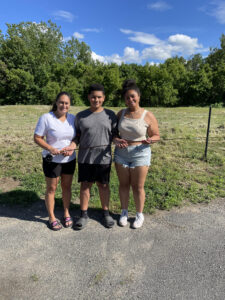
Incidentally, while delivering the rod, I learned that Chase was quite a young outdoor sportsman. He had also inherited Joe’s archery equipment including his bow, arrows and targets. (The arrows had Joe’s name printed on them). He, his mom and sister Chalyce are members of an archery league taught by Mark Jester at the Lenox Sportsmen’s Club. He has already received an Archer’s Perfect Score award. The folks at the Lenox Sportsmen’s Club are pretty high on him and are sponsoring him to attend the two week Mass Junior Conservation Camp later this summer. I’ll bet Joe feels good about that, too.
Rest assured Joe, your legacy lives on.
Areno’s Legacy fly
Hook: Size 6, 4X L streamer hook
Tail: Gray squirrel tail – represents the squirrel tails that Joe gathered up and kept in his freezer for his fly tying friends. (He may also have provided some to Mepps Company for their spinning lures. Each year Mepps put out a public call for squirrel tails and Berkshire Eagle Outdoor Columnist Ted Giddings included it in his column.)
Body: Rabbit fur dyed forest green signifying Joe’s love for rabbit hunting and his efforts to restock club property with snowshoe hares. It also signifies the many acres of forest that Joe helped to procure for the Pittsfield Sportsmen’s Club, making it the club with the most landholdings in Massachusetts. Through his efforts, nearly 1,000 acres of Potter Mountain were preserved as open space.
Collar and Wing: Deer hair (dyed black) which signifies the many deer that Joe harvested over the years. But more significantly, it acknowledges the many deer that Joe skinned and prepared for cooking for the club’s many venison fundraising dinners.
Head (thread): The deer collar and black thread head represent Joe’s dark black hair which he maintained until his illness.
Carp Palooza
This year’s Carp Palooza event will take place on Pontoosuc Lake on Saturday, June 15. Sign-up will take place at the Pontoosuc Lake boat ramp between 10:00 am and Noon and the fishing competition runs from Noon to 10:00 pm.
There will be cash payouts to the winners and to 2nd and 3rd place, pending the number of entries. Two person teams, $50 per team. Awards will be given for the best combined weight for 2 carp. Lunker Pool optional at $20 per team. Championship belts will be awarded to the winners. There will also be a 50/50 raffle as well as a $100 Lottery Tree raffle. There will be a prize for the largest Mirror Carp. The Dink award will be awarded for the smallest carp.
eregrine falcon numbers continue to grow in Massachusetts
P
Being an outdoor sports columnist, I frequently write about ducks, geese, woodcock, pheasants, grouse, turkeys, etc. But last week, a MassWildlife Media Advisory was received entitled: “State Officials Band Rare Peregrine Falcons in Newburyport.” The public was invited to view the banding, but unfortunately, the advisory came in too late for me to include in last week’s column. It was scheduled to take place on May 29. So, why not write about these beautiful raptors anyway?
Information regarding these birds on the MassWildlife web site revealed the following information:
The peregrine falcon (Falco peregrinus) is the fastest bird on earth, capable of diving from great heights at speeds of up to 240 miles per hour. Males are 15–18 inches in length with a 35–42-inch wingspan; females 18–20 inches in length with a 42–48-inch wingspan.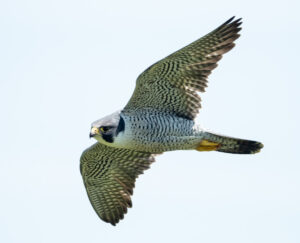
Before 2017, peregrine falcons were listed as endangered in Massachusetts. In 2019, their status in the state was improved to Special Concern, a status they still have today. Peregrine falcons were removed from the Federal Endangered Species List in 1999.
Peregrine falcons have long, pointed wings and long, slightly rounded tails. Adults have a bluish-gray to slate-gray backside and a buffy white underside that is speckled with black. Adults also have a black crown and black mustache-like markings that look like sideburns. The throat is white. The bill is dark except for a prominent yellow fleshy base called a cere. The legs and feet are yellow. Immature peregrines have a brown backside and a heavily streaked underside.
Adults generally live about 10 years. The longest known lifespan of a peregrine falcon was 17 years. Most peregrine falcons nest at 2 to 3 years old. Once they are established, adults remain in their territory throughout the year. By March 1, adult pairs choose their nest site for the season. By the beginning of April, 4 or 5 eggs are laid. The chicks hatch in early May and fledge (leave the nest) in mid-June. By the beginning of August, chicks become independent of their parents. During their first fall and winter, young peregrine falcons disperse around New England finding territories of their own.
Peregrine falcons are specially adapted to capture birds in flight. In Massachusetts, they almost exclusively hunt for other birds. The most frequent prey species include pigeons, blue jays, and European starlings. Their best known hunting strategy is to soar high over their territory and wait for a bird to fly past far below. They then dive straight down in a controlled dive called a stoop, where they can reach speeds over 240 miles per hour. The small bird flying below does not even know that it was targeted.
Historically, peregrine falcons nesting sites, (called eyries), within Massachusetts were located on rocky cliffs but today they also nest on tall man-made structures like buildings and bridges. Buildings that have consistent peregrine falcon nests can be found in Boston, Chelsea, Cambridge, Watertown, Lawrence, Lowell, Worcester, Amherst, and New Bedford. They nest on bridges in Charlestown, Fall River, West Springfield, and Northampton.
To boost nesting success, MassWildlife and MassDOT have installed several nest boxes across the state. Leg banding provides MassWildlife biologists with useful information about the birds’ movements, lifespan, and injury recovery.
In the late 1940s, the effects of the pesticide DDT began taking their toll on peregrine falcons. Accumulation of DDT caused falcons and other birds to lay thin-shelled eggs that broke under the weight of incubation. By 1955, due to the widespread use of harmful pesticides like DDT, there were no nesting peregrine pairs left in Massachusetts.
Restoration efforts began in 1972, coinciding with the ban of DDT and attempts to release captive-bred chicks occurred in 1975–1979 with no success.
In 1984 and 1985, MassWildlife and partners released young falcons in downtown Boston, successfully leading to the first modern Massachusetts nest in 1987 on the Customs House Tower in Boston. There are now nearly 50 territorial pairs of peregrine falcons in Massachusetts. This is more than triple the 14 pairs that nested in Massachusetts in the pre-DDT era of the 1930s.
This year marks the 38th year of peregrine falcon restoration efforts in Massachusetts, and over 1,077 wild-hatched chicks have fledged from nests in the state since restoration efforts began.
Do we have to travel to eastern Massachusetts to see these amazing birds? Absolutely not. If you are patient, lucky, and know where to look, you will see them on Monument Mountain.
Berkshire National Fish Hatchery youth fishing derby
Bring your children aged 13 and under next Saturday, June 8 to the monthly Friends of the Berkshire National Fish Hatchery Youth Fishing Derby at the Hatchery’s Derby Pond at 240 Hatchery Road, New Marlborough.
It runs from 9:00 to 10:30 am. Watch them learn to fish and compete for prizes. No child goes away empty handed.
Pittsfield Sportsmen’s Club youth fishing event
The Pittsfield Sportsmen’s Clubs (PSC) is sponsoring a free, kids fishing day at Reynolds Pond in Cheshire off Fred Mason Road on Saturday June 8 from 9:00 am to 1:00 pm. It is for kids 12 and under and their parents don’t have to be PSC members.
There will be three tagged fish, poles and bait available, also snacks and juice boxes for the kids.
For more information, contact Sandra and Ed Bushey at (413) 443-9371.
Housatonic River Cleanup
Volunteers are invited to help clean up the west branch of the Housatonic River with Berkshire Environmental Action Team (BEAT) and Housatonic Valley Association (HVA) at one of their annual river cleanups on Sunday, June 9, from 9:00 am to Noon. After the cleanup, volunteers will be provided a free lunch from a local restaurant. Volunteers must RSVP in advance to reserve a free lunch.
Participants should meet at Wahconah Park, 105 Wahconah Street, Pittsfield, at 9:00 am. Cleanup teams will disperse to nearby locations, gathering miscellaneous trash from the river banks and bottom. Canoes will be used to transport the trash. Old clothes, a hat, sunscreen, old sneakers or waterproof boots/waders, a full water bottle, and sunglasses are recommended. In the event of pouring rain or lightning, the cleanup will be postponed to Saturday, June 29.
Cleanups make a considerable difference in the health of the Housatonic River. Over the years, BEAT and HVA have collected a startling array of debris — including mattresses, shopping carts, inflatable pools, bicycles, televisions, tires, construction materials, metal barrels, and all kinds of everyday trash. Once, they even found an empty ATM. Since beginning annual cleanups, their efforts have made a noticeable difference, with the piles of trash getting smaller. BEAT feels that this wouldn’t be possible without the help of their volunteers.
You are invited to join BEAT and HVA at a cleanup this summer to see what else may be in the River and make a difference for the environment. Register at www.tinyurl.com/Housatonic-River-Cleanups-2024. For more information, visit thebeatnews.org or call (413) 464-9402.
West Branch Housatonic River Cleanups are organized by Berkshire Environmental Action Team (BEAT) and Housatonic Valley Association (HVA) and co-sponsored by Blue Q, Panera Bread, and the City of Pittsfield.
Possible “pin” fish caught at the Stockbridge Sportsmen’s Club fishing derby
Last Sunday, April 19 was a beautiful day for the SSC Fishing Derby with temperatures in the 60’s. The derby, which ran from dawn to 1:00 pm was organized and run by Club members Tim Minkler and George Chasse. There were 44 anglers entered into the contest which was lower than past years, but some nice size fish were caught. All fish were released after being weighed and measured. The following information was provided by Tim Minkler:
Adult Winners ($100 dollars)
Largest Pickerel: Mike Soncini, Housatonic, MA 4 lbs., 8 oz., 25 ½ inches long. If the weight and length held up on state certified scales, it qualified for a sportfishing award pin in the catch and release category. It was the heaviest fish of the day.
Largest Trout: Conner Casey, Housatonic MA, 1 -lb., 15 oz, 14 inches long
Largest Bass: Tim Fogerty, Lee MA, 3 lbs., 10 oz., 18 ½ inches long (He caught another bass slightly smaller)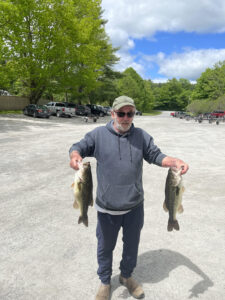
Tim Fogarty with 2 bass. Picture taken by Gene Chague
Largest Bullhead: Tom Methe, Washington MA, 1 lb., 5 oz., 13 ½ inches long
Age 12 and Under Winner:
Mya Methe, Washington MA, Bullhead: 10.4 oz, 10 ½ inches long
This year they had a food trailer on site for the first time (Laura’s On The Go). The variety and quality of food was great.
Trout Stocking
The following waters were scheduled to be stocked with trout last week. This is the last of the scheduled spring 2024 weekly trout stockings.
Ashfield Pond, Goose Pond, Laurel Lake, North Pond, Onota Lake, Pontoosuc Lake, Richmond Pond, Stockbridge Bowl and Upper Highland Lake.
Many thanks go out to Deb Lipa and Leanda Fontaine from the DFW Western District Headquarters in Dalton for providing the weekly trout stocking information to us. I’m sure it resulted in more work for them and they did not have to do it. If you are in their neighborhood, you may want to stop in and thank them.
Youth Artist from Acton Wins Junior Duck Stamp Contest
Meghan Li from Acton won Best of Show in the 2024 Massachusetts Junior Duck Stamp (JDS) Contest. Her colored pencil and soft pastel drawing of a hooded merganser was selected from 267 entries. Li’s award-winning work will represent Massachusetts at the National JDS Contest.
Students from kindergarten through grade 12 from across the Commonwealth submitted original works of art depicting waterfowl in their natural habitats, demonstrating both artistic talent and a knowledge of the value of wetlands for wildlife. In March, a panel of judges selected the top works of art in each of four age groups. A combination of the top artworks will be exhibited throughout Massachusetts in the coming year.
The Massachusetts JDS Program is sponsored by MassWildlife and the U.S. Fish and Wildlife Service, with support from the Massachusetts Sportsmen’s Council. Please support the JDS Program and wetland conservation by purchasing Junior Duck Stamps featuring national winners from previous years. Stamps can be purchased at duckstamp.com.
Congratulations Cindy Delpapa
In a recent press release, The Wild & Scenic Westfield River Committee awarded Cindy Delpapa, of Becket MA. the Bob Thompson award for her dedication to the river and the breadth of knowledge she shared for the benefit of all. “Her high standards and clarity of focus guided the committee through an update of the strategic plan, development of a website focused on action, and a model for funding culvert replacement across the watershed that improves safety and river habitat at the same time.”
“Cindy was instrumental in launching two new initiatives, “Rooting out Barberry” and exploring “Brine for Pretreatment” to prevent ice from forming on our Hilltown roads in winter. Cindy brought Action Research in to assist the committee with developing campaigns that speak directly to the audience we are trying to reach in a manner that is clear, inspiring and motivating.
If you are interested in the Committee’s work or participating in its initiatives visit https://westfieldriverwildscenic.org/.
Spring turkey hunting ends today
Sorry, if you haven’t bagged a wild turkey yet, then you will have to wait until the fall turkey hunting season to get another chance. The fall season opens on October 7 in our zone.
Help MassWildlife with its annual summer wild turkey count. Every year from June 1 to August 31, wild turkey reports from the public help their biologists determine productivity, compare long-term reproductive success, and estimate fall harvest potential. Reports are welcome from all regions of Massachusetts, from the most rural communities to more densely-populated areas. The summer wild turkey survey is a fun way for people to connect with nature while contributing valuable data to MassWildlife biologists.
You are encouraged to report wild turkey sightings in your area. Contribute to the annual wild turkey survey by reporting observations of hens (female turkeys), poults (newly-hatched turkeys), jakes (juvenile males), and toms (adult males). Click onto the MassWildlife web page to learn how to tell the difference between male and female turkeys.
Turkey sightings can now be submitted online using a form which can be downloaded. The form was updated in 2023 to include a map that allows collection of more accurate location information. Users have the option to zoom to their location on the map or type in an address.
Basic Hunter Education course
Basic hunter education is mandatory for all first-time adult hunters. MassWildlife offers Basic Hunter Education in two formats, in-person or blended.
A blended course is being offered at the Ashfield Rod & Gun Club, 161 North Street, Plainfield on Saturday, June 15 from 8:00 am to 4:00 pm.
To enroll, call 508-389-7830 or click onto: https://www.mass.gov/info-details/basic-hunter-education-course for all the details
All courses are free of charge and open to the public.
United States Practical Shooting Association
USPSA is a fun and fast action shooting sport where participants balance accuracy, power, and speed into a winning combination. Multiple targets, moving targets, targets that react when hit, penalty targets, or even partially covered targets, obstacles, movement, and other techniques are all used to keep USPSA shooters challenged and spectators engaged. USPSA matches are held all over the US with local clubs holding matches practically every day of the week. You probably already own everything you need to compete in USPSA. The cost is $20 and they are held at the Lee Sportsmen’s Association. Cold Range Rules apply.
The times and dates are as follows for 10:00 am shoots: Registration 8:30 am, safety briefing 9:30 am. on the following dates: June 2, July 7, August 4, September 1, October 6 and November 3.
The times and dates are as follows for the 12:00 pm shoots: Registration 10:30 am, safety briefing 11:30 am on the following dates: June 16, July 21, August 18, September 15 and October 20.
They also have a “Steel Challenge.” Check the LSA web page for those details.
There’s music in the air
Beagle music, that is. On June 8, the Berkshire Beagle Club, 380 Sleepy Hollow Road in Richmond, is sponsoring a SPO (Small Pack Option) derby on rabbits and hares. It starts around 8:00 am. The Club has two fenced in running grounds.
If you want to see what it is all about, just drop over. You can contact Chris Wilser (845)489-6554 or Jeffrey St. John (413)441-0744 for more details.
Memorial Day Weekend
It’s that time again when we honor those who have fought, suffered and/or died in defense of our nation. Look around and see the beautiful, peaceful woods and waters that we have here in the Berkshires and compare that to what is going on in so many other parts of the world. There was a price that had to be paid to have this and the people we honor this weekend paid it. Please, let us not forget that.
Wild Acres Youth Fishing Derby had another great turnout
Last Saturday, May 11, the Wild Acres Youth Fishing Derby took place with over 100 children registered. The age range was from 2 1/2 to 14 years old. The weather was very cooperative and it was a lovely morning.
This was the 10th year that the City of Pittsfield Conservation Commission and Lyon Aviation sponsored the event. Representing the City of Pittsfield were Maddy Brown, Recreation & Special Events Coordinator and Rob Van Der Kar, Pittsfield Conservation Agent. Assisting the anglers were Onota Fishing Club volunteers. Dave’s Sporting Goods Store, Onota Boat Livery and Parks and Recreation provided bait, fishing poles and tackle; Lyon Aviation provided the brook trout which came from the Berkshire National Fish Hatchery in New Marlborough. Ozzie’s Steak and Eggs provided free food vouchers to 100 people from their food truck. Berkshire Regional Planning Commission (BRPC) and the Onota Boat Livery donated a number of fishing poles that were raffled off throughout the morning.
Only 1 of the 400 stocked brook trout was caught as bass were the most popular catches of the day. Actually, the largest fish caught was a 17 inch, 2.2 lbs. largemouth bass, which was caught by Troy Sparrow.
Mylles Tagole caught the sole trout. Some pumpkinseeds, bullhead and pond shiners were also caught.
I can’t tell you how many folks commented on the fond memories they had of their dads or granddads bringing them to this little pond to learn how to fish. Today, the tradition continues and now they are bringing their kids and grandkids.
One notable person missing this year was the late Clem Caryofilles of the Onota Fishing Club who recently passed beyond the riverbend. For many years he was heavily involved in this event and we really missed him. Incidentally, age is taking its toll on the Onota Fishing Club membership and its numbers are shrinking. Perhaps its time for the next generation of folks to step up to the plate to keep this tradition alive.
Our hats are off to Lyon Aviation, the City of Pittsfield, the Onota Fishing Club, BRPC and everyone involved to make this event a great success.
A huge thank you goes to Maddy Brown for providing information on the derby winners and other pertinent information.
Trout stocking
The following local waters were scheduled to be stocked with trout last week, subject to change: Deerfield River in Buckland, Charlemont, and Florida, Green River in Alford, Egremont, and Great Barrington, Housatonic River C&R in Lee and Stockbridge, Housatonic River East Branch in Dalton and Hinsdale, Konkapot River in Monterey and New Marlborough, Littleville Reservoir in Chester and Huntington, North Pond in Florida, Westfield River East Branch in Chester, Cummington and Huntington, Westfield River West Branch in Becket, Chester, Huntington and Middlefield, Onota Lake, Richmond Pond and Stockbridge Bowl.
MassWildlife staff honored
In a recent public announcement, current and former MassWildlife staff were recognized for their contributions to fisheries and wildlife conservation.
The Robert McDowell Award
This is the highest honor presented by the Directors of the Northeast Association of Fish and Wildlife Agencies to honor career professionals who have made significant contributions to advance fish and wildlife conservation in the Northeastern United States and eastern Canadian Provinces. Jim Cardoza, retired MassWildlife Biologist, was presented with this award at the 79th annual Northeast Fish and Wildlife Conference hosted by MassWildlife on Cape Cod in April.
Cardoza’s accomplishments during his long tenure as a wildlife biologist in Massachusetts are impressive. Notably, he was the key architect of the restoration of wild turkeys in the Northeast. Turkeys were absent in Massachusetts until reintroduction efforts began in the late 1960s. Today, Massachusetts’ wild turkey population is estimated at around 35,000 birds! Jim also pioneered innovative methods for studying black bears and became one of the country’s leading experts on this species. He shared his expertise by publishing dozens of peer-reviewed articles and presenting at professional conferences ensuring that other wildlife professionals had access to the latest wildlife management methods and research results.
This honor took on special significance since Mr. Cardoza accepted the Robert McDowell Award at his 50th Northeast Fish and Wildlife Conference.
William T. Hesselton Memorial Award
Every year, a group of wildlife professionals from 13 Northeast states nominate an individual who has made significant contributions to wildlife conservation and to wildlife management and hunter training programs. Susan Langlois, MassWildlife’s Hunter Education Program Administrator, received the William T. Hesselton Memorial Award at the Northeast Fish and Wildlife Conference. Langlois has dedicated her career to the conservation of Massachusetts wildlife and to providing top-notch instruction to the sporting community. Drawing on her expertise as a biologist, Susan has become an advocate for science-based wildlife management and a national leader in developing modern hunter education program standards. She helped develop a national trapper education course and is an instructor and advisory member for the national Conservation Leaders for Tomorrow program.
Berkshire County League Sportsperson of the Year
The third award recipient was Leanda Fontaine, MassWildlife’s Western District Aquatic Biologist, who was named (BCLS) 2023 Sportsperson of the Year. The award was given by the BCLS at the Silvio O. Conte Memorial Banquet on April 13. During her nearly 20 years with MassWildlife, Fontaine has been involved with a variety of statewide fisheries research and conservation projects. In her current role, she oversees fisheries projects in western Massachusetts, plans trout stocking activities and public stocking events, and supports learn-to-fish classes in the Berkshires. Leanda has implemented several successful invasive water chestnut removal projects, contributes her knowledge to lake and pond management discussions, and is the MassWildlife representative on the interagency scientific dive team.
All three were also honored by the MA Fish & Wildlife Board at its May 15 meeting.
Annual Harry A Bateman Memorial Jimmy Fund Fishing Derby coming up
The 32nd Annual Harry A. Bateman Memorial Jimmy Fund Fishing Derby will take place on Saturday, June 1, (rain or shine), at the Frank Controy Pavilion at Onota Lake in Pittsfield, from 6:00 a.m. to 12:00 p.m. No fishing license is required because it is Free Fishing Weekend.
This fishing derby is perhaps the most important and largest of our local fishing derbies. Open to the public, its purpose is to raise money for the Jimmy Fund – Dana Farber Cancer Institute. All proceeds will be donated to the Jimmy Fund in memory of Harry A. Bateman a former member of Central Berkshire Bowman & I.U.E. Local 255 who was well known throughout Berkshire County and who became a victim of cancer in 1992.
Many trophies and prizes will be awarded to the winners of the fishing derby – 8 trophies for children, 4 trophies for adults and 3 trophies that can be won by adults or children. There is even a special category for those carp fishing with a bow & arrow. All fish must be weighed in at 12:00 p.m. and can be caught at Onota Lake from a boat or the shore.
The fee, which includes food and beverage, is $10 for adults, $5 for children 14 years old and younger. Advanced tickets may be purchased at Avid Sports, 201 West Housatonic Street, Dave’s Sporting Goods, 1164 North Street and Onota Boat Livery, 436 Peck’s Road, all in Pittsfield. Everyone needs to register at the Frank Controy Pavilion. Even if you can’t make the derby, donations to the cause will be graciously accepted.
June 1–2, is Free Freshwater Fishing Weekend
Mark your calendars for this year’s Free Freshwater Fishing Weekend on June 1 and 2. No license is required to fish any public lake, pond, reservoir, stream, or river in Massachusetts from 12:00 am. Saturday, June 1 until 11:59 p.m. Sunday, June 2.
For saltwater anglers, Free Saltwater Fishing Weekend is June 15–16.
Other than on Free Fishing Weekend, you need a license to fish in fresh water if you are 15 or older. If you’ are 15–17 or 70 and older, your license is free.
All other regulations, including catch limits, apply during Free Fishing Weekend. Before heading out on the water, make sure you know the rules.
Funds from fishing license sales support MassWildlife’s fisheries research, fish stocking programs, and angler education programs.

